| Article ID | Journal | Published Year | Pages | File Type |
|---|---|---|---|---|
| 4389134 | Ecological Engineering | 2014 | 5 Pages |
Abstract
Hexavalent chromium [Cr(VI)] is considered a hazardous water pollutant. Thus, the removal of Cr(VI) is necessary for the protection of the environment. In this study, two lab-scale constructed wetlands vegetated with Leersia hexandra Swartz (CWL) were set up to purify Cr(VI)-contaminated water. X-ray absorption near-edge spectroscopy (XANES) and X-ray photoelectron spectroscopy (XPS) were employed to determine the speciation of chromium (Cr) in plant tissues and substrates, respectively. Results showed that the CWL efficiently removed Cr(VI) from water. XANES analysis revealed that Cr was predominantly trivalent in plant tissues, although minimal Cr(VI) was observed in roots. In substrates, the majority of chromium existed as trivalent chromium [Cr(III)], whereas only 5.9% of chromium existed as Cr(VI). Therefore, CWL is capable of detoxifying through the reduction of Cr(VI) to Cr(III). We propose that CWL has a great potential for decontaminating and detoxifying water contaminated with Cr(VI).
Related Topics
Life Sciences
Agricultural and Biological Sciences
Ecology, Evolution, Behavior and Systematics
Authors
Jie Liu, Xue-hong Zhang, Shao-hong You, Qing-xin Wu, Shi-min Chen, Kai-ning Zhou,
